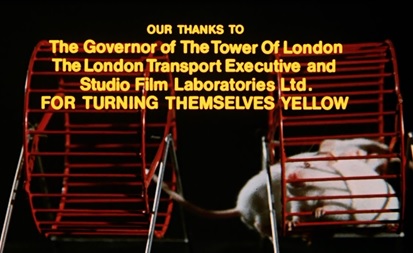In Cinema and Colour, Paul Coates remarks that after an extensive IMDB search, he found only 311 film titles that referenced the colour yellow compared with 2,018 for red and 1,459 for blue.[i] To this relatively short list we can add The Boy Who Turned Yellow, a film curio that was released in 1972. The film was produced by the Children’s Film Foundation (CFF) a non-profit making organisation set up in June 1951 with the mandate of creating films exclusively for children. The CFF pioneered colour in Toto and The Poachers (1957) which according to the film journal Kinematograph Weekly was the ‘first feature length children’s film to be made in colour’.[ii] But it wasn’t until the latter 1960s that colour became standard for CFF productions and Eastmancolor became the ‘go to’ colour process.
The Boy Who Turned Yellow is perhaps the most famous CFF film to have emerged throughout its prolific thirty year output. It remains best known for being the last collaboration between Michael Powell and Emeric Pressburger who created now British classics such as A Matter of Life and Death (1946), Black Narcissus (1947) and The Red Shoes (1948) – all films with highly expressive colour palettes. According to director Powell, it was a dream of Pressburger to make a film solely intended for children, and he both devised the story and wrote the screenplay. It is fair to say the result is something of a creative tour de force in terms of British children’s cinema.

Filmed on a modest budget (one hour CFF features produced in the early 1970s cost around £30,000)[iii] it featured other big names behind the camera including cinematographer Christopher Challis and art director Bernard Sarron; both were collaborators on previous Powell and Pressburger films. Eastmancolor proved an affordable and adaptable colour stock and a scan through the back catalogue reveals that most CFF colour productions were filmed using the Kodak process. The film was processed at the Studio Film Laboratories in London. It was shot with Panavision cameras which Challis later described in interview as being ‘small, light and marvellous to use’.[iv] This flexibility allowed easier access to various exterior film locations including the Tower of London and a disused section of the London Underground. A footnote to the end credits thanks all participating organisations and institutions ‘for turning themselves yellow’.

But – why yellow? Well, the film features a strong educational component that involves much explanation about how electricity works with scientific lessons on solar light and energy creation. The ‘boy’ in question (Mark Dightam) has little interest in the subject until one day when he is travelling home from school and suddenly turns bright yellow on a London tube train. The direct look to camera and lapse of the cinematic ‘fourth wall’ re-affirms to us the strangeness of the situation.
The boy then goes on a fantastical adventure with a bizarre character dressed in a yellow boiler suit and skis called Nick (from ‘electronic’) and played by Robert Eddison. This journey takes him through a television screen as he travels the energy waves to retrieve his lost pet mouse from the Tower of London. He ends up being chased by a group of Beefeaters before almost losing his head at the guillotine. The whimsical story with its flashes of Alice in Wonderland is accompanied by a fantastic electronic score by Patrick Gowers and David Vorhaus.
Despite the prestige team behind The Boy Who Turned Yellow, and according to Powell’s later memoires, the CFF nearly shelved the finished product. This may have been due to concerns about the lack of coherent narrative and psychedelic visuals. But it proved very popular with the most critical viewers of all – the CFF audience themselves. As Robert Shail comments in his recent study: ‘it is fortunate that Powell won out as it remains one of the most unique films in its entire output’.[v] Despite accolades bestowed on the film in more recent times, there remain questions about how certain scenes were shot and the application of colour in terms of make-up, costume and set design. These are the type of questions we hope to answer in our project and The Boy Who Turned Yellow provides a useful case study to begin our own journey into this unchartered realm of investigation.
The Boy Who Turned Yellow was recently screened in its 35mm colour print taken from the original negative at the BFI Southbank as part of the UK Colour Group Symposium on 27th March 2017
____________________________________________________________________________________________
[i] Paul Coates, Cinema and Colour: The Saturated Image, (London: British Film Institute, 2010), p.87
[ii] Josh Billings, Kinematograph Weekly, Vol. 488, No. 2627, 19 December 1957, p.12
[iii] Henry Geddes, ‘The Economics of the Children’s Film Foundation’, Film Finance, No. 3, December 1970, p.22-23
[iv] Christopher Challis, BFI Interview 11/10/1988, p.30
[v] Robert Shail, The Children’s Film Foundation: History and Legacy, (London: British Film Institute, 2016), p.76



[…] in 1972, The Boy Who Turned Yellow is a fantasy about a boy who is upset after losing a pet mouse on a visit to the Tower of London. […]
LikeLike